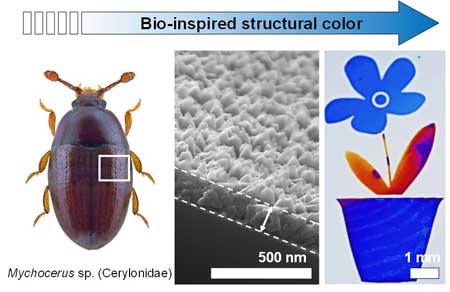| Posted: Jul 07, 2017 |
Flexible and cost-effective fabrication of nature inspired structural colors
(Nanowerk News) Throughout nature, colors generally arise from two sources: pigment colors and structural colors. For application purposes, pigments or dyes that absorb light are considered to be the traditional method to color materials due to their ease of usage. Despite their strengths, there are negative aspects to pigment colors such as potential for environmental damage during the manufacturing process and photochemical degradation which results in fading of the original color.
|
|
Structural colors, on the other hand, produce color through nanostructures that reflect or scatter light. Feathers of birds and the scales of butterflies are two of the many examples of structural colors in nature. Furthermore. their structural spacings allow for the production of more distinct colors than is possible through pigments.
|
|
However, despite the many advantages of structural colors in various applications, high fabrication costs and the inability to change a structural color once it has been applied has curtailed widespread implementation.
|
 |
| In this study, structural colors were reproduced using quasi-ordered scattering to mitigate these issues. To this end, a ZnO flower-like structure having unimodal distributions of size and spacing was fabricated by ZnO hydrothermal growth. (© ACS)
|
|
Research conducted by Geunbae Lim, a professor with the Department of Mechanical Engineering at Pohang University of Science and Technology (POSTECH), in collaboration with Taechang An, a professor with the Department of Mechanical Design Engineering at Andong National University, has successfully developed a new and cost-effective method for obtaining biomimetic structural colors with the ability to finely tune the completed structures.
|
|
This achievement has been published in ACS Applied Materials & Interfaces ("Bioinspired Structural Colors Fabricated with ZnO Quasi-Ordered Nanostructures").
|
|
The team used quasi-ordered scattering--the phenomenon where a constructively reflected wavelength is observed when nanostructures with the same size are uniformly distributed over an irradiated area-- through ZnO nanostructure fabrication. By successfully synthesizing ZnO into desired shapes through selective growth and etching, the team discovered the technique for large-scale and flexible fabrication of structural colors.
|
|
The synthesis process and the resulting nanostructures can be fine-tuned by controlling the time and reagent concentration, and furthermore, masking techniques allow for the application of different structural colors on the same surface.
|
|
Lim remarked on the noteworthiness of this research because the proposed method has overcome existing limitations and is expected to be applicable to many fields including the eco-friendly fabrication of microelectrodes, sensors, and anti-tampering tags.
|

